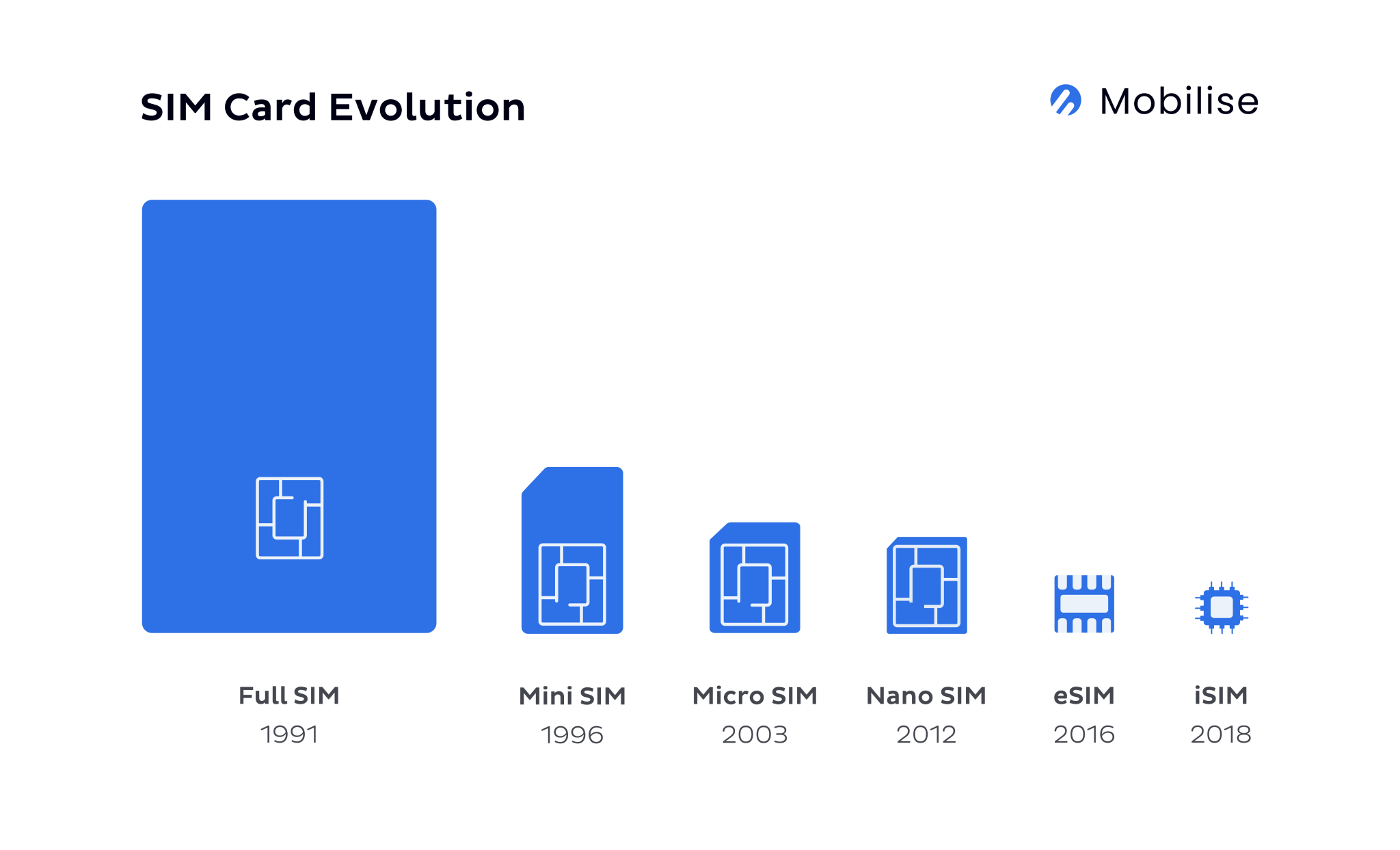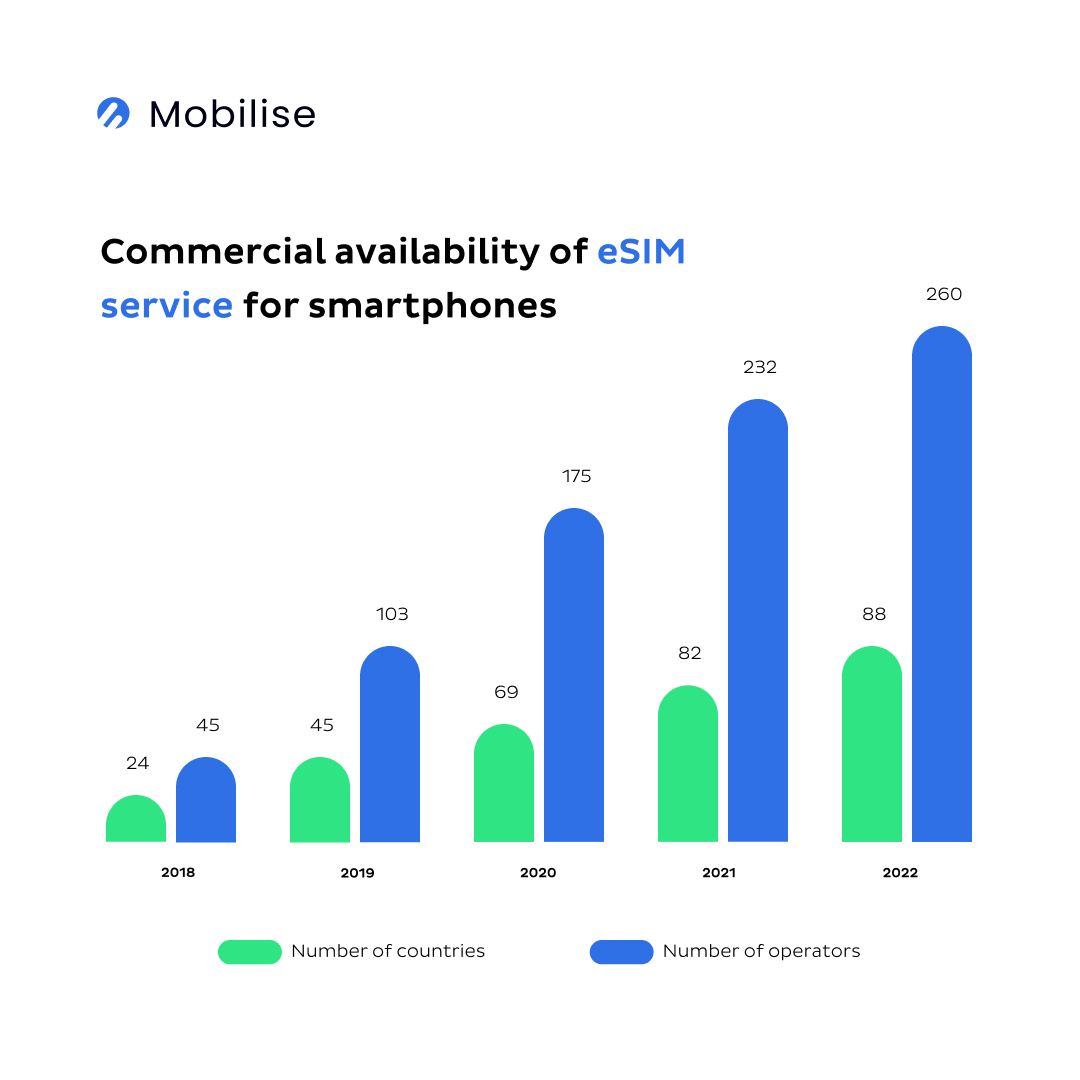When did eSIM come out? Who invented eSIM? In the ever-evolving landscape of telecommunications, the emergence of eSIMs (embedded Subscriber Identity Modules) has marked a revolutionary shift in how we connect and communicate.
As we navigate the intricacies of our digitally-driven world, it becomes crucial to understand the origins, evolution, and inventors behind this transformative technology.
TL;DR
- Traditional SIM cards date back to 1991 when they assumed the role of mobile phones in hosting mobile operators’ authentication parameters.
- An eSIM serves as a digital alternative to a physical SIM card, enabling mobile phone users to connect to a network provider entirely digitally, eliminating the need to insert or swap physical SIM cards.
- eSIMs emerged in 2010 in the IoT market and gained traction in the consumer market in 2016.
- Unlike traditional SIM cards, eSIMs do not have a single inventor; they were developed collaboratively by the GSMA.
- As technology continues its rapid evolution, the adoption of eSIMs is expected to increase, driven by their positive impact on device design and user experience.
Understanding eSIM
In simple terms, an eSIM functions as a digital SIM card that cannot be physically removed from a device.
Traditional physical SIM cards house essential authentication parameters, such as the international mobile subscriber identity (IMSI) number and its key (Ki), necessary for establishing a connection between a device and a network provider.
The eSIM serves the same purpose but takes a different form. Rather than being a removable plastic card, it’s seamlessly integrated into the device. Making it non-replaceable and eliminating the need for physical swapping.

Moreover, unlike traditional SIM cards, eSIMs don’t come pre-programmed with authentication parameters. Instead, these parameters are stored in an eSIM profile, which users must download over the air and activate through a remote SIM provisioning (RSP) process.
Despite the seemingly intricate process, it only takes a minute. The advantages, however, are substantial. Unlike plastic SIM cards, which are pre-programmed and restrict users to a single network provider, eSIMs are reprogrammable and can accommodate multiple eSIM profiles simultaneously. Users have the flexibility to choose and seamlessly switch between profiles with just a tap of their finger.
RECOMMENDED READING
eSIM history
Consumer eSIM technology has been around for nearly a decade. To understand its significance, we first need to delve into the definition and history of traditional SIM cards.
The inception of Subscriber Identity Module (SIM) cards dates back to 1991, representing a ground-breaking development. That’s when network authentication parameters migrated from the device to a separate card. This shift liberated mobile devices from a lifetime commitment to a single service provider. The flexibility afforded by SIM cards allowed users to seamlessly switch between mobile devices or service providers without mutual interference.
To transition between service providers, a user only needed to replace the existing SIM card with a new one on the same device. Similarly, when upgrading devices, retaining the same service provider and phone number became effortless by transferring the SIM card from an old mobile device to a new one.
SIM cards operate on universal integrated circuit card (UICC) technology like bank cards. They feature a programmable integrated circuit (IC) chip storing vital authentication parameters — the international mobile subscriber identity (IMSI) number and its key (Ki) — crucial for establishing a connection between a mobile user and a network.

Initially, SIM cards mirrored the size of credit cards. However, as mobile devices progressively reduced in size, so did SIM cards, starting with the “standard SIM” or “regular SIM”. Eventually, this size evolution culminated in the nano SIM, the smallest possible iteration introduced in 2012, reflecting a continuous adaptation to the evolving landscape of mobile technology.
When did eSIM come out?
eSIM made its debut in the Internet of Things (IoT) sector in 2010, aiming to simplify the challenges associated with the insertion and programming of physical SIM cards into IoT devices.
This innovation alleviated the logistical complexities associated with inserting or swapping SIM cards, particularly in unmanned or inaccessible connected objects.
It then became evident that the same technology could be applied to consumer devices, a concept strongly championed by Apple. The eSIM chip, approximately half the size of the nano SIM, prompted Apple’s motivation to minimise the valuable real estate occupied by SIM cards within their devices. Little did they know that this initiative would play a pivotal role in revolutionising the digital transformation of mobile services.
The GSM Association, widely known as the GSMA, was initially reluctant to introduce eSIMs to the consumer market due to security concerns. Eventually, the use of eSIM in the consumer market was approved.
The consumer eSIM emerged in 2016, marking the commencement of a new era in the telecoms industry.
Who invented eSIM?
eSIM technology wasn’t the result of a single inventor. Instead, it was developed collaboratively by the GSM Association (GSMA), an industry association of mobile network operators and related companies.
The GSMA played a key role in establishing standards and specifications for eSIM technology, ensuring interoperability and widespread adoption across the telecommunications industry.
To find out more, read our consumer eSIM white paper.
eSIM evolution and adoption
eSIM made its debut in wearables, and interestingly, Google led the charge with the first eSIM-compatible handheld device, the Pixel 2, in 2017. Following suit, Apple swiftly incorporated eSIM compatibility into its iPhone XR and iPhone XS models.
While Apple long held the crown for the most extensive line-up of eSIM-capable smartphones, Samsung recently surpassed it with 26 eSIM-friendly models as of October 2023, with Google closely trailing in the top 3, boasting 19 eSIM-friendly smartphones.

In 2019, Motorola’s RAZR broke ground as the inaugural eSIM-only smartphone, lacking a physical SIM slot. However, it was Apple’s introduction of the eSIM-only iPhone 14 (in the US only) in September 2022 that truly captured the spotlight, overshadowing previous attempts.
Presently, flagship smartphones from major manufacturers feature eSIM as a standard, alongside the traditional SIM slot.
Apple’s pioneering eSIM-only iPhone in the US significantly heightened consumer awareness, fostering a growing appetite for eSIM offerings.

As per a GSMA Intelligence report, consumer awareness of eSIM was approximately 20% in 2020, and recent data from 2022 indicates a modest increase, remaining below 30%.
Awareness levels vary based on regions, generations, and smartphone brands owned by consumers. Despite these distinctions, the overall trend persists – eSIM awareness is low and experiences slow growth.
The future of eSIM
Looking ahead, the future of eSIM in the consumer market appears poised for transformative growth.
eSIM adoption is expected to gain further momentum, with reports suggesting that 98% of operators plan to offer eSIM services globally by 2025. This signifies a substantial increase from the current adoption rates, emphasizing a significant industry-wide commitment to embrace eSIM technology.

Consumer awareness, though historically low, is anticipated to rise. The eSIM Consumer Pulse 2022 report reveals that 81% of surveyed customers across the US, UK, and Australia are either in favour of, or open to, the concept of eSIM-only smartphones. This growing openness suggests a shift in consumer preferences towards the convenience and flexibility offered by eSIM technology.

Source: The eSIM Consumer Pulse 2022
By 2025, it’s projected that 83% of smartphone shipments will be eSIM-enabled, reflecting a substantial increase from the current landscape. This shift signifies a significant industry-wide acknowledgement of the benefits eSIM brings to both consumers and operators alike.

Adapted from: Counterpoint
As eSIM-compatible smartphones become more affordable and accessible, their widespread adoption is expected to catalyse further changes in the consumer market.
Operators need to seize the moment, focusing on promoting eSIM awareness, enhancing customer experiences, and transitioning to fully digital eSIM models. Mobilise’s eSIM as a Service platform remains a crucial tool for telcos looking to navigate the changing landscape efficiently.
RECOMMENDED READING
50 eSIM statistics every telecom service provider needs to know in 2024
Conclusion
In conclusion, the exploration of eSIMs’ history reveals a significant evolution in connectivity. From its introduction in 2010 for the IoT segment to its subsequent adoption in consumer devices, eSIM has transformed how we connect. Unlike traditional SIM cards, eSIM is a digital, non-removable option endorsed by major players like Apple and Google.
While the invention of eSIM lacked a single originator, the collaborative efforts led by the GSMA shaped its development. Looking ahead, the future of eSIM promises increased adoption and a pivotal role in reshaping telecommunications.
In essence, the concise history of eSIM emphasises its transformative potential and role in establishing seamless, digital connectivity as the new standard.



